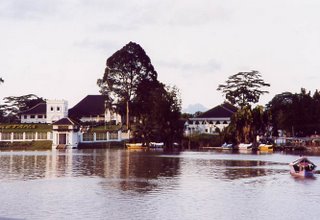
The capital of Sarawak is Kuching City, located on the southwestern end of this largest state in Malaysia. Kuching City has a population exceeding 300,000 in year 2006 and is expected to grow up to 500,000 by year 2015. What makes this city very unique, among a host of other things, is that a river meanders right through the heart of the city, almost dividing it equally in half. The river, known as the Sarawak River, meanders through the city and flows west-easterly to meet another equally-sized river, the Kuap River. The photograph (source:
www.community.iexplore.com) shows a very famous and rather historically significant landmark along the river, that is the Astana, i.e. the official residential of the Governor of Sarawak. This building was built more than a 100 years ago by the "white rajahs" of Sarawak, the Brooke family. They came over (an English gentleman named James Brooke sailing in his ship, The Royalist) sometime in mid-19th century to the then younger Sarawak, landed here, loved the place, made some deals to take it over from a member of the royal family of the sultanate of Brunei (who apparently owned Sarawak then) and subsequently became "rajah" or king of Sarawak. Fantastic story for some, less fascinating for others.
Today, this river has become Kuching City's most celebrated and well-known sight-seeing location for both local and foreign visitors alike. With the construction of a beautiful esplanade along the southern bank of the river for as long as 1 km, completed in 1993, this has added much vigour to the peaceful settings of the river as it moves along down to the sea.



















